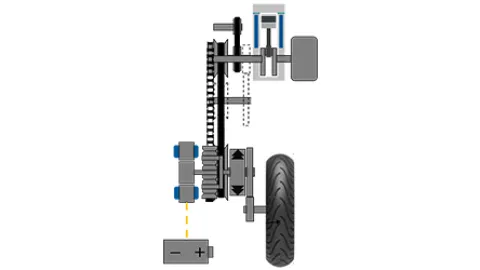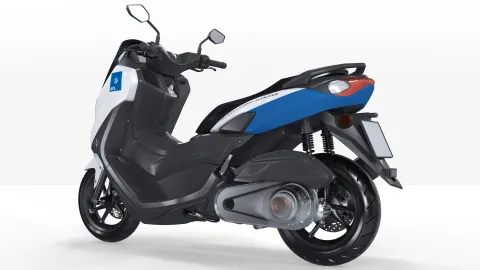Development of Hybrid Motorcycles
- Expert Article
Christian Martin
Senior Product Manager
General Market Overview
Upcoming, increasingly stringent greenhouse gas as well as emission limits demand for powertrain electrification across all vehicle applications. For two-wheelers, motorcycles and all-terrain-vehicles (ATV) the main drivers for electrification are sustainability, carbon neutrality, and the social impact of minimizing emissions and noise. Two-wheeler applications face significantly different constraints than automotive and commercial vehicles, such as tight packaging and mass targets, limited charging infrastructure in densely populated urban areas, as well as small, partially removable batteries for home charging as well as demanding cost targets.
Battery electric two-wheelers are the ideal choice for transient driving in urban areas with limited range requirements. Hybridization provides considerable advantages and extended operation ranges.
In addition to improving efficiency, silent and zero-emission modes enable fully electric driving, while combined boosting enhances performance and transient response.

2-Wheeler Hybridization
In general, there are two different two-wheeler categories for hybrid powertrains:
- Motorcycles featuring frame-integrated internal combustion engine (ICE) and transmission units, coupled with secondary drives via chain or belt;
- Scooters equipped with integral single-sided swingarm power units, featuring an internal combustion engine with a continuously variable transmission (CVT).
A promising concept for a hybrid scooter powertrain allows efficiency improvement combined with additional benefits of electric driving: utilizing a power-split electrified continuously variable transmission (e-CVT) with a planetary gearset. In this hybrid concept, the planetary gearset seamlessly manages the modulation of the transmission ratio interacting with the e-motor’s operation modes. We developed a hybrid strategy, considering the power demand and battery state of charge (SOC) in parallel with the implementation of all driving modes.

Hybrid Strategies for 2-Wheelers
Hybrid operating strategies can be classified into three main categories based on their functionality: optimization-based, rule-based, and heuristic and learning-based.
In optimization-based operating strategies, continuous optimizations or calculations to minimize energy consumption are done in those vehicles, which are used to determine the operating modes and parameters. This type of energy management can be further subdivided into numerical, analytical, and immediate minimizations based on the method used. They differ from rule-based strategies mainly in their increased computational requirements.
Various manifestations of rule-based/heuristic operating strategies are known, differing in their complexity and interpretation of the rules. In rule-based operating strategies, the choice of the optimal operating mode for the current driving conditions is made according to defined rules and principles. Advanced hybrid concepts from P2 onwards offer the capability of fully electric driving, with the option to disconnect the internal combustion engine and allow zero-emission, silent operation in urban areas to meet evolving legislative requirements. Power split hybrid solutions provide significantly increased efficiency and facilitate load point shifting, battery charging and energy recuperation to adapt performance requirements in urban and rural operation.
Layout of the E-CVT Hybrid Powertrain
In continuously variable transmissions, the gear ratio can be varied arbitrarily, allowing it to assume all values within certain system limits. The power flow does not need to be interrupted by a shifting process, as in transmissions with fixed gear ratios in conventional motorcycle transmissions. CVTs can be classified into three main categories based on their construction: mechanical, hydraulic, and electromechanical CVTs. In conventional applications in the small motorcycle or scooter sector, mechanical continuously variable transmissions with push belt or plastic wedge belts are used.

A promising hybrid scooter powertrain concept allows combining efficiency improvement with additional benefits of electric driving – utilizing a power-split electrified continuously variable transmission (e-CVT) with a planetary gearset.

The e-CVT scooter can be categorized as P4, thus labeled as a hub motor drive. Additionally, it is classified as a power split hybrid since the division of system power into mechanical and electrical paths is realized through the planetary gearbox. In this hybrid scooter concept, the standard CVT is removed and the planetary gearset seamlessly manages the modulation of the transmission ratio interacting with the e-motor’s operation modes. With the e-CVT, in hybrid mode, the stepless adjustment of the gear ratio can be achieved by controlling the speed of the electric motor, with the planetary gear system unblocked (i.e., freely movable).

Summary and Outlook
A promising hybrid scooter powertrain concept allows combining efficiency improvement in the range of 20 % in World Motorcycle Test Cycle (WMTC) with additional benefits of electric driving – utilizing a power-split electrified continuously variable transmission (e-CVT) with a planetary gearset. In this hybrid concept, the planetary gearset seamlessly manages the modulation of the transmission ratio interacting with the e-motor’s operation modes. A hybrid strategy, considering the power demand and battery state of charge was developed concurrently with the implementation of all driving modes.